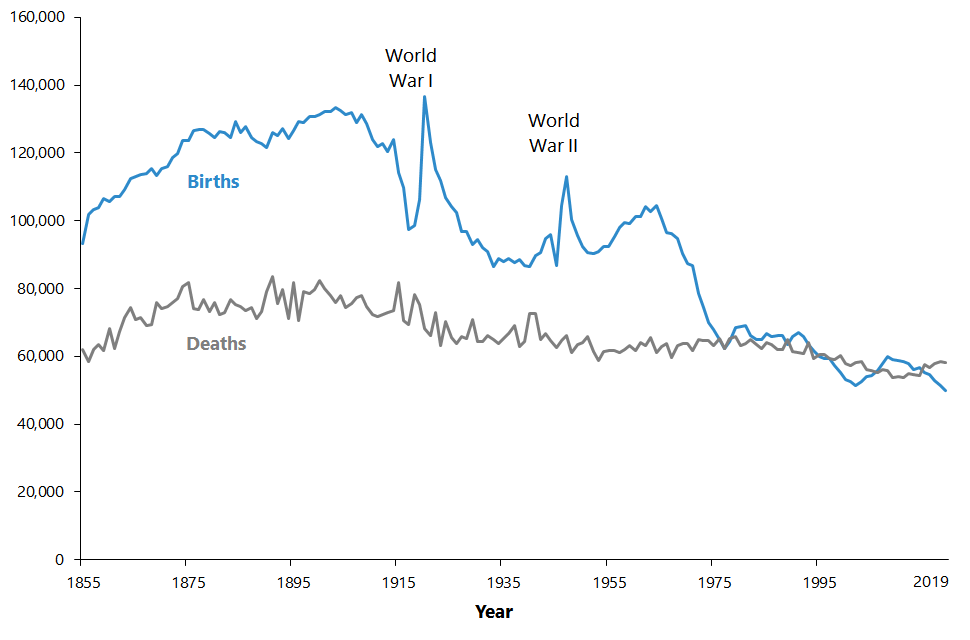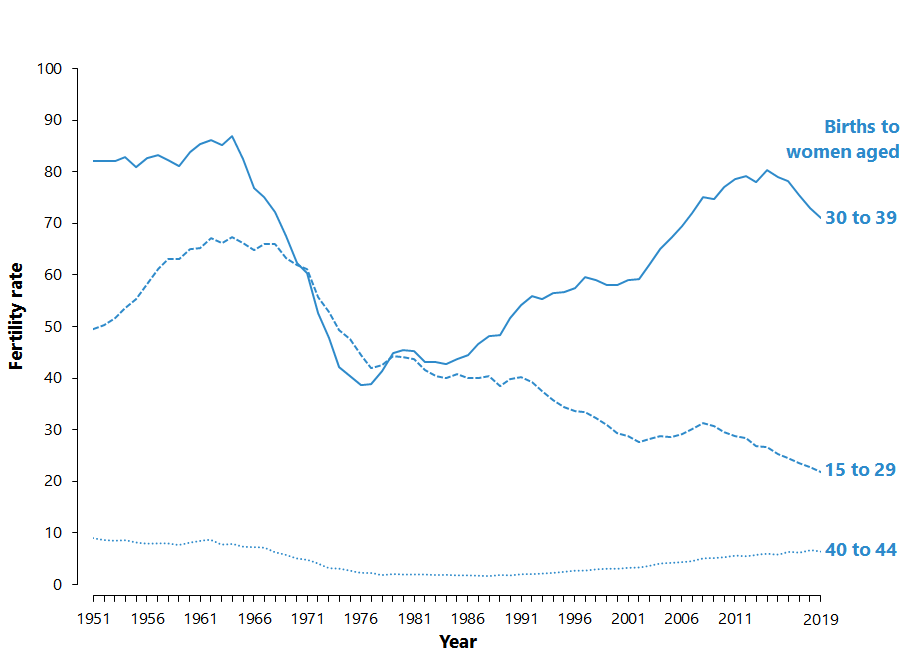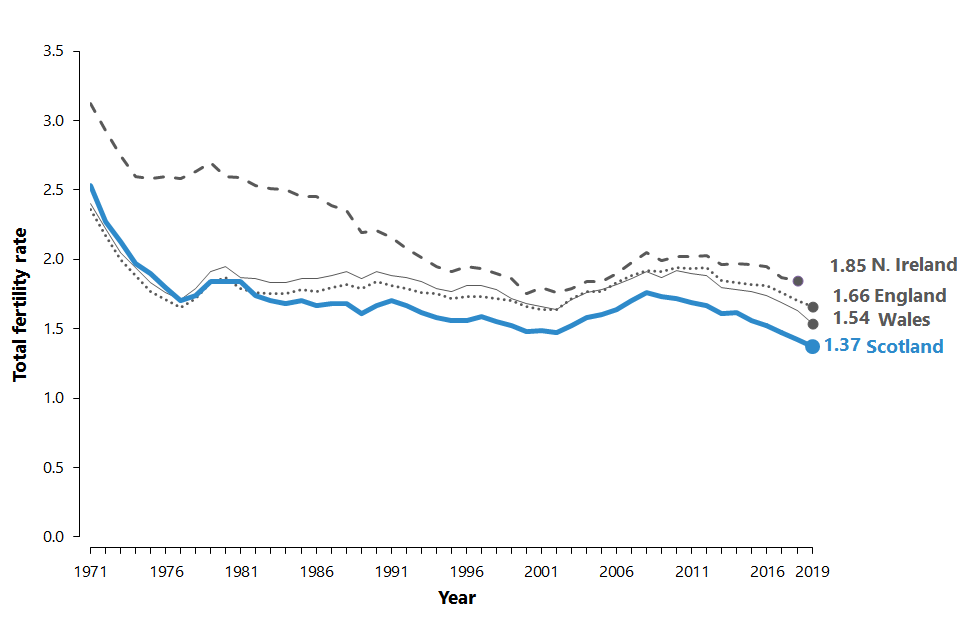Chapter 3: Births
"The number of births in Scotland in 2019 was the lowest ever recorded"
Births and COVID-19
The latest annual figures available on births in Scotland are for 2019. It is expected that the number of births in 2020 will not have been affected greatly by the COVID-19 pandemic, as most babies born in 2020 were conceived before the pandemic started.
Although there are provisional figures on births available for 2020 (up to end June), it is worth noting that most birth registrations were postponed from the second part of March 2020 due to the pandemic. In late June, a staggered reintroduction of birth registrations was introduced. This means that the weekly and monthly data on birth registrations and the quarterly births data don’t reflect the true number of births during this period.
The impact of the pandemic on the number of births in Scotland will only begin to become clearer when the first provisional 2020 data is published in Summer 2021.
Births up to 2019
There were 49,863 births recorded in 2019, which is the lowest number ever recorded.
The changes since 1855 are illustrated in Figure 3.1. During the 20th Century, the number of births fell by 60%, from 131,000 in 1900 to 53,000 in 2000. This reflects a number of substantial changes such as improvements in healthcare and reductions in child mortality, improved access to contraception, changes in attitudes and more career opportunities becoming open to women.
The number of births in Scotland in 2019 was the lowest ever recorded – the first time there have been fewer than 50,000 births
During the 21st Century, the number of births rose from a low of 51,270 in 2002 to a peak of 60,041 in 2008, before falling steadily to 49,863 in 2019. Until the 1970s, there were far more births than deaths each year in Scotland, but this gap then began closing. And now, since 2015, there have been more deaths than births (also known as negative natural change) each year, and the gap has widened to 8,245 in 2019.
Figure 3.1: Births and deaths, Scotland, 1855-2019

Age of parents
On average, people are having children later in life, and having fewer children overall.
As well as having fewer children, people are tending to have children at older ages. Figure 3.2 shows that the number of births to females aged under 30 has fallen in recent years. The number of births to females aged 30-39 has fallen since its peak in 2014, having steadily risen since the 1980s before this. Females aged 30 and over accounted for over half of all births in 2019. The number of births to mothers aged 40 and over has also steadily risen since the 1980s, but fell slightly in the past year.
Figure 3.2: Live births per 1,000 women, by age of mother, Scotland, 1951-2019

The average age of mothers rose from 26.0 in 1975 to 30.7 in 2019. Similarly, the average age of fathers rose from 28.4 in 1975 to 33.2 in 2019. This excludes births registered in the mother’s name only, where the father’s details were not provided.
How does fertility vary across Scotland?
The Total Fertility Rate (TFR) gives the average number of children per woman, that a group of women would expect to have if they experienced the observed Age Specific Fertility Rates in each of their childbearing years. Using the Total Fertility Rate makes it easier to compare different areas and changes over time.
In 2019, the Total Fertility Rate (TFR) for Scotland was 1.37 children per woman. For a population to replace itself, this figure needs to be around 2.1.
In Scotland, the Total Fertility Rate is lowest in the cities. The lowest is the City of Edinburgh, with a Total Fertility Rate of 1.01 children, followed by Glasgow City at 1.18. The highest figures tend to be in areas outside the main cities, such as Midlothian (1.77) and Aberdeenshire (1.68).
How does fertility in Scotland compare with the rest of the UK?
Figure 3.3 shows that in the 1970s, the Total Fertility Rate in Scotland was slightly higher than in England and Wales. Through the 1980s, fertility rates fell further in Scotland, and have continued to remain lower than in other parts of the UK. Fertility rates for all UK countries have fallen since 2008, with Scotland falling at a faster rate than the other countries.
Figure 3.3: Total fertility rates, UK countries, 1971-2019

Footnote: The label for Northern Ireland quotes the 2018 total fertility rates because at the time of writing the 2019 figure was not available.
Country of birth of parents
Country of birth of mothers
73% born in Scotland
9% born in the rest of the UK
8% born in the rest of the EU
9% born outside the EU
Of the mothers who had children in 2019, 73% had been born in Scotland. A further 9% were born in the rest of the UK and 8% elsewhere in the European Union (EU), including 5% from the countries which joined the EU in 2004 or later (the largest number were to mothers born in Poland). Commonwealth countries were the birthplace of 5% of mothers, including 3% from the Indian sub-continent. In the cases where the father’s country of birth was known, 83% had been born in the UK, including 73% who were born in Scotland.
In 17% (8,079) of births in 2019 neither parent was born in Scotland, including 12% (5,864) of births where neither parent was born in the UK. These figures compare to 14% and 9% respectively in 2009. These statistics only consider the births for which both the mother’s and the father’s countries of birth were known (47,713 out of 49,863).
More information about birth statistics
More detailed information about Scotland’s births can be found in the Vital Events – Births section or in the Births section of the Vital Events Reference Tables on the National Records of Scotland website.